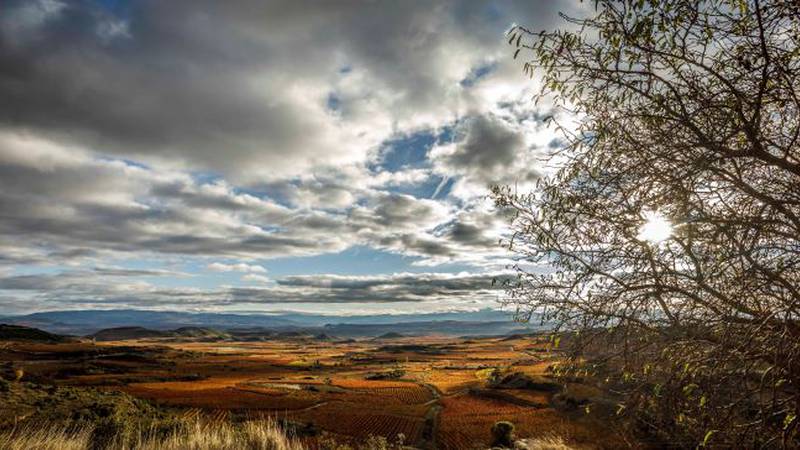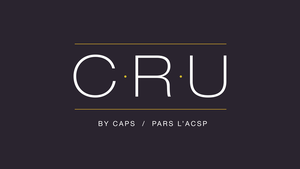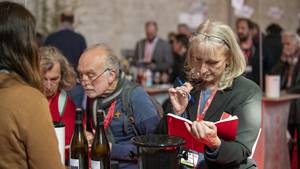Introduced in 2017, new regulations became official in Rioja as of January 1st, 2019. The biggest changes were around origins. Others included the addition of new authorized white grapes varieties and modification of ageing requirements for traditional categories such as Rioja Reserva DOCa. Sparkling wine was also introduced as an official appellation of the region.
While many of those changes were long waited for, some of the details around the policies have left some people questioning. (Full details on new regulations). To better understand the subtleties around some of the most important modifications, I interviewed three key players: María José López Heredia of R. López de Heredia Viña Tondonia and Rafael Vivanco of Vivanco. It is important to note that Rafael Vivanco is on the technical committee of the Consejo Regulador. Finally, rounding out this informed discussion on the subject is Sarah Janes Evans MW. Sarah is an award-winning wine writer and journalist, and author of many books and articles on Spain.
The Big Change: subzones, villages and unique vineyards
Spain’s long-established wine region of Rioja is made of 66 000 ha of vines found over three subregions (now known as zones): Rioja Alta, Rioja Alavesa and Rioja Oriental (formerly Rioja Baja). Each of those areas have a different micro-climate and are blessed with different type of soils. Add to this multiple whites and reds grapes, about 15 000 landowners and you have the back story of a long tradition of purchasing crops and blending. Blending of parcels, sub-regions and grapes. It came not only from the need to purchase enough grapes to make wine, but it hailed from the idea that those regions and grapes were complimentary.
But with this tradition, got lost the celebration of the great sites. Imagine the Rhône Valley with only Côtes du Rhône as an appellation, without having the pleasure of seeing Hermitage or Gigondas on a label. And what if we never acknowledged the amazing parcels of La Turque or La Landonne?
While locals are aware of the great diversity of Rioja, it has not been communicated to consumers. The strong marketing of brands took over, leaving the great sites in the shadow. As of last year, producers can add the name of the subregion, village or municipality on their front labels. Vineyards that overlap two municipalities (villages) are allowed to blend up to 15% of the neighboring villages’ grapes into their wine. Viñedos Singulares (VS) (unique vineyards) were also introduced. However, if made from purchased grapes, they can only be from growers’ producers with whom they have had shared a 10 year minimum of uninterrupted commercial partnership. Other rules include the vines need to be a minimum of 35 years old, lower yield requirements and wines must go through a tasting panel to confirm their right to have the certification.
Michelle:
While this is definitely a step in the right direction, some people may question the lack of hierarchy within the villages or the unique vineyards categories. Also, unlike in Burgundy, a single vineyard cannot be owned/shared by two producers. I asked my panel what they thought.
María José López Heredia:
“Rioja, historically, had a tacit classification of villages. Anyone who made wine in Rioja knew perfectly the difference of grapes grown on each village. Having said this, it is true that 100 years ago this classification was not used as a quality differentiation for customers but as an inside differentiation for winemaking and for the prices of grapes. Which means there were differences, even when the grapes were going to be used for blending them in one wine. It once existed and it makes sense to make a 100% wine of a village. But as you well say, in one village could be two different qualities, etc., it is complex. Nevertheless, even if Burgundy is an inspiration for us and we can learn a lot from Burgundy, we should have our own way of classify our wines more adapted to our history and our past.”
Sarah Janes Evans MW:
“Something of this order has been long overdue. Rioja has plenty of diversity of soils, aspects, altitudes which have been known to growers but have not been communicated to consumers. It’s a region that can produce wines of exceptional quality and age worthiness but hitherto the generic brand Rioja has been stronger than a specific villages or vineyards. (Whereas, for example in Burgundy, there are some vineyard names which are more famous to wine drinkers than merely ‘Burgundy’.
It is very useful to have Village wines as a category. It recognises the origin more narrowly and begins to build a quality pyramid. Villages also have a meaning in Rioja. Wine tourism is important, and it’s a lovely area to visit. You can see the villages distinctly from the road, and village wines are very natural as a category. BUT there is a critique that village wines can also contain wines from a neighbouring area, diluting the wine (and the message). And importantly a village wine needs to be made in a winery in the main village. This is a great pity because it means that it affects those producers who make wines from a number of villages, but understandably only have one winery.
The single vineyards are going to take time to settle down. Some people are definitely entering their wines, others choosing not to. This are transitional times. Good things about the legislation are the smaller yields, older vines etc. But there are things I don’t like. There’s the fact that producers cannot share the same vineyard and vineyard name. As a result, you can’t get something wonderful which is what you get with for example with El Rapolao in Bierzo, with a range of producers all working the same vineyard. And at the same time, we must not believe that a single vineyard is always the best. Some of the greatest Riojas are blends across the region, with Tempranillo from Rioja Alta and Garnacha from Rioja Oriental for example. What I would like to see is more wineries talking more about their vineyards and their growers. Hitherto the focus has been on the winery. A typical consumer visit used to be all about admiring the hundreds and thousands of barricas in the cellar. Gradually wineries are getting the message that the vineyard is important.”
Rafael Vivanco:
“It’s important to say that they are only two quality levels with Viñedos Singulares on the top. Wines with the mention of subzone or municipalities do not have stricter requirements besides traceability. The two latter are not about quality but about the possibility for producers to show the typicity of a place...Maybe it doesn’t seem as perfect as when you look at the model of Priorat or Burgundy, but we don’t want to copy anyone. We want to establish something that reflects our history. I insist that it is better to have it and work in that direction. And in the future, we will polish many details and improve.”
___________________________________________________________________________________________________________
The New Varietals
Today, seven grapes make 99% of the production in Rioja but in 1942, the region was blessed with 17 different varietals and in the early 20th century, 42. Therefore, it is not a surprise that new grapes were included, and I foresee this to continue over the years. It is now possible to produce single variety white wines from any of the more recently authorized varieties (Garnacha Blanca, Malvasía, Maturana Blanca, Tempranillo Blanca, Turruntés, Chardonnay, Verdejo and Sauvignon Blanc) and label them as such.
_________________________________________________________________________________________________
Michelle:
On that list of new varietals, Chardonnay and Sauvignon Blanc may raise a few eyebrows. Why introduce international grapes when the region is blessed with great indigenous grapes suited to the terroir of region?
María José López Heredia:
“This is a long and big discussion in Rioja. Any wine area in a complex world of competition looks for maintaining original character which it is very much given by indigenous grapes. We, at López de Heredia, have always been defenders of indigenous grapes and still are. In fact, I believe that ever since Rioja approved new international grapes more Rioja producers have been defenders of Viura, Garnacha blanca or Malvasía. Indeed, if you used international grapes you lose somehow the “Rioja character”. But it should always be the consumer who has the last opinion on whether they want Rioja character or “Chardonnay”. The wine has to be good nevertheless.”
Sarah Janes Evans MW:
“I’m not a fan of these international varieties. Rioja can make lovely wines with what it has had, and the white wines are getting lovelier all the time. People are working, changing techniques in the vineyard, but also there’s a diversity of management in the winery – concrete, large vats, old oak, stainless steel, amphoras…. The one thing that might really drive change to different varieties is climate change, and the need to find varieties that are tolerant. (We saw Bordeaux open the doors to 7 or so new varieties for this very reason.) But growers are looking for higher altitude vineyards, which can help. Rioja has a proud history. I’d like to see it seeking out the traditional varieties (Maturana Blanca being perhaps the oldest of them all). Many are difficult to work with, but they are its heritage.”
Rafael Vivanco:
“There was a big debate in the DO and I was against it. But it is by votes and some big wineries and coops voted for it. Their philosophy is not for the long term and they wanted to authorize Verdejo, Sauvignon Blanc and Chardonnay which are not indigenous grapes in Rioja. But even though they were accepted, in reality not many wines from those grapes are produced. In fact, I think that this decision has encouraged many producers to celebrate even more indigenous grapes. This can be noted in the increased planting. For examples, in 2012 we had 30 to 40 hectares of Garnacha Blanco. Now we have 216 hectares. This increase can also be noted with Tempranillo Blanco (now 738 ha). If planting of Chardonnay, Verdejo and Sauvignon Blanc increased when they were first authorized in 2007, they have been stagnant since.
Michelle:
Which of the ‘new’ indigenous grapes are you the most excited about?
Rafael Vivanco:
“I love Maturana Blanca! In the 17th century, Rioja had more whites than reds and the first reference in a text about grapes in Rioja is Maturana Blanca. I love it because it is fresh, it has high acidity, lots of body and density. And I like the aromatics a lot, as they remind me of the fragrance of German white wines. It is ideal in a blend. I think that Tempranillo Blanco is promising but the vines need to get older until we can understand its full potential. Also, of the 4.9 hectares of Turruntes planted in the region, I have 1. But I need to wait for the root system to develop until I can see the potential.
For the reds, I love Maturana Tinta. I have vines planted in three different terroirs. Unlike Tempranillo, it is not sensitive to heat. It is adapted to climate change as it keeps its acidity and it is not too high in alcohol. I like the freshness and the peppery character it brings to a blend, but I also think there is great potential as a single grape. And I must say, I love the revival of Garnacha (Grenache) in Rioja. More vines are being planted and at high altitude and this is a great thing.”
_________________________________________________________________________________________________
Espumosos de Calidad de Rioja
I was very excited to see this new category as it will allow producers from Rioja to sell their wines as Espumosos de Calidad de Rioja rather than Cava. Quality white and rosé sparkling wine must be made from traditional method. However, many regulations differ from those of those of Cava. For example, the ageing requirements are as follow: minimum of fifteen months for Crianza, twenty-four months for Reserva, and thirty-six months for Gran Añada. Moreover, grapes must be hand harvested. Only Riojas’ authorized grapes are allowed and 25 per cent of the grapes must be red, if rosé is made. Specific regulations were also put in place for vintage, Brut Nature, Brut and Extra Brut sparkling wines, in addition to other stipulations.
___________________________________________________________________________________________________________
Michelle:
Do you see sparkling wine as part of the identity of Rioja?
María José López Heredia:
“Yes. In the history of Rioja, Bodegas Bilbaínas always made sparkling wine and this is one of the reasons why Rioja is in the Cava DO. They have been making it very successfully for many years so why Rioja shouldn’t be able to make bubbles? We, at López de Heredia, particularly do not think about making it since we focus on what we have always done. Our great grandfather tried to make sparking and he gave up. We do not know exactly why. But I believe that Rioja has the grapes and the vocation to make sparkling wine.”
Sarah Janes Evans MW:
“There have always been fine traditional method sparkling wines in Rioja. Not many though. Producers across Spain should be free to make traditional method sparkling if they wish and can find a quality market. What I really want sparkling wine producers to do is to see them talking openly about their origins. This is my issue with Cava as it currently is – it is made in a number of places, which means among other things that there are stylistic differences in the fruit. Let’s be frank about that and celebrate it. So traditional method sparkling from Rioja, as opposed to Navarra or Ribera, or Requena, or Penedes, yes please.”
Rafael Vivanco:
“It is a very promising category and it has a lot of potential. Historians say that the first evidence of traditional sparkling wine made in Spain (in 1857) was in Rioja and not Catalonia. Until the 1930s or 40s, Rioja wineries made sparkling, but it was not possible to put it on the label, you had to put Cava. But the problem with that is that you are limited to make sparkling with grapes authorized in the Penedès which does not make sense at all.
This is the reason why I put this category forward to the Consejo and 93% of people on the committee agreed. I was asked with another producer to develop the regulations. We have a fresher climate here (than in the Penedès). Our grapes have more acidity, so we need extra time for the wine to integrate and get balanced. Which is why after some trials (in 2015 and 2016) I asked for the right to experiment in the winery which I was granted. As a result, I proposed a 15-month minimum requirement ageing on the lees (as opposed to 9 months for Cava). This was not about copying Champagne; the wines from our region need this. The idea behind the regulations is also to promote quality rather than quantity.”
Michelle:
I asked Rafael which grapes within the authorized one, were more suited to sparkling wine in Rioja. He refused to share his secret. He said as a clue that his Blanc de Blancs Reserva and his rosé, which both will be released next October are mostly made from the ‘new’ indigenous grapes. I will be looking for them!
The Future of Rioja
Michelle:
Even Rioja, a region rich in tradition and history, is capable of adapting, evolving and embracing changes. The new regulations put in place are a testament to this. How do you see the future of Rioja, I asked?
María José López Heredia:
“Rioja has a lot of past so it should have a lot of future. Life is always changing and evolving, and Rioja should adapt to new challenges. Humans base evolution through changes even when some changes are made to end up in the origin. I believe Rioja should focus on protecting quality. And quality is the most difficult term to define and protect. And this is something Rioja has been trying to do since 1926. I am totally sure that in 100 years we will be still trying!!!! No appellation in the world is perfect but if in between we make wines that give pleasure the world will get the profit out of it. This is all I can say.”
Sarah Janes Evans MW:
“Rioja has been super-successful in marketing. It is such a strong brand, and one that is internationally recognisable. Inevitably, with such a strong message, subtleties are lost. The DOCa is finally recognising this. The recent work introducing online courses is a really good thing (worth a visit!). Education, education, education.
For the future – these regulations will continue to develop and become more subtle. We will get to learn more about Rioja’s sub-regionality. The different styles will continue to develop and progress: traditional, classical, modern, neo classical, whatever. Rioja has terrific growers, winemakers, viticultures, and owners – listen to them. Rioja is a brand, but it’s also a collection of individuals, as diverse as the terroir they work in.”
*Cru by CAPS & the Canadian Association of Professional Sommeliers would like to thank and acknowledge the Rioja DOCs and other funding partners for supporting the production of this content.






